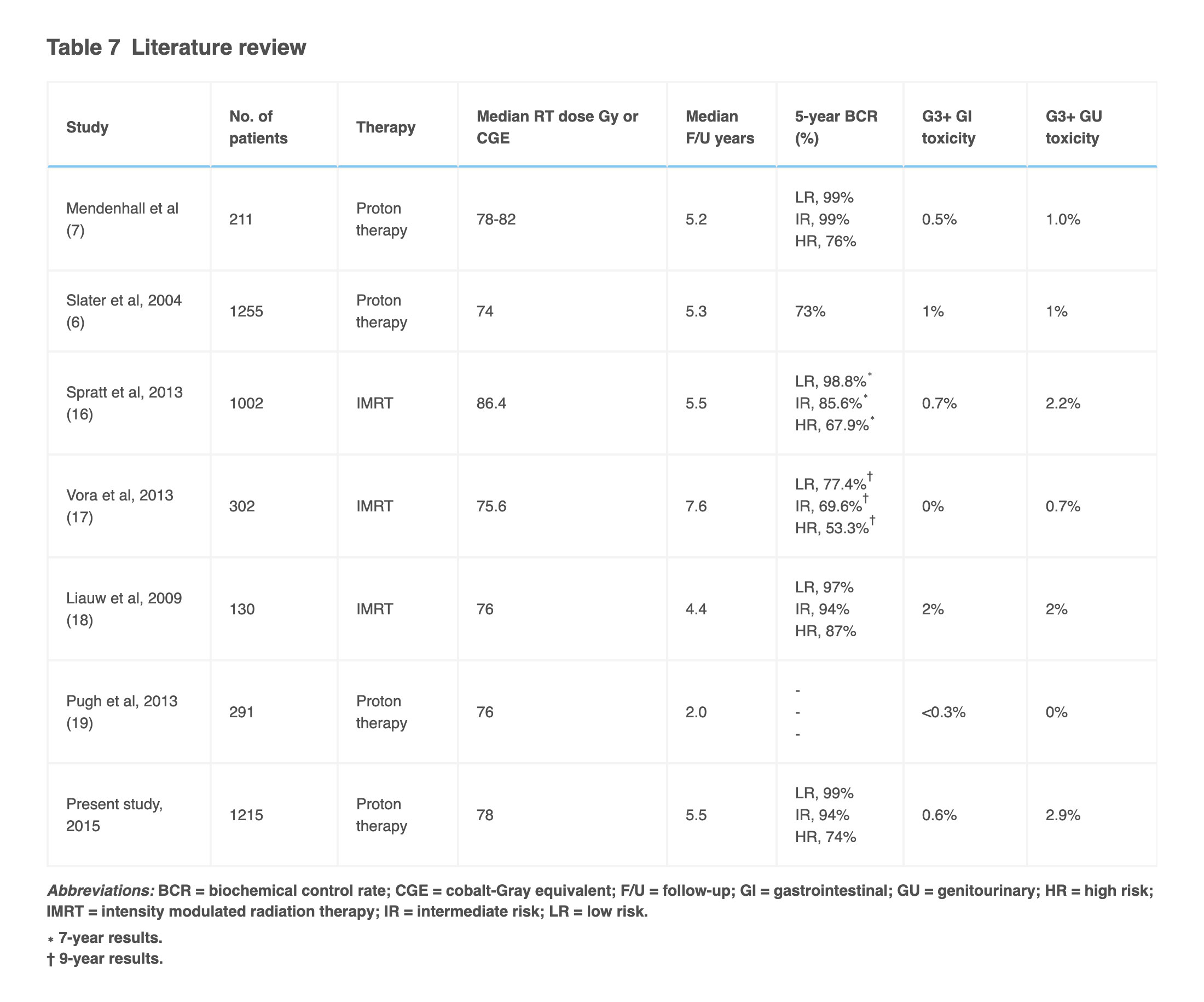How does proton therapy compare with IMRT for prostate cancer treatment outcomes?
UF Health Proton Therapy Institute published in the May 2016 issue of the International Journal of Radiation Oncology Biology Physics a study that reports 5-year outcomes of more than 1,300 prostate cancer patients treated at the Institute from 2006 to 2010. The study shows that proton therapy is a highly effective treatment for low-risk, intermediate-risk and high-risk prostate cancer. It also reports a low rate of serious side effects.
There are no prospective comparative studies for a definitive comparison of proton therapy with IMRT. The following table from the study provides some guidance on patient outcomes following prostate cancer treatment with either proton therapy or IMRT.

We at the University of Florida Health Proton Therapy Institute are fully committed to gaining a better understanding of the impact of utilizing protons to treat prostate cancer. Our published data is based on treatments delivered with well-defined dose levels and toxicity documented by detailed follow-up questions and examinations of our patients. Actual results, reported by patients and their physicians, are utilized in our research studies.
We currently offer treatment for a wide range of cancers with CRT, IMRT, brachytherapy (radioactive seeds) and proton therapy. We have both IMRT X-ray therapy and proton therapy available for the treatment of prostate cancer. We likewise have many patients on watchful waiting. Our physicians do not have an ownership stake in our facility nor our equipment. They are salaried faculty members of the University of Florida College of Medicine and have no direct financial incentive that might influence their recommendation regarding any particular treatment alternative.
We strongly encourage all prostate patients to become better educated about their disease and the different options for treatment. We likewise encourage patients to take the time and effort to question the data from all sources.
Citations:
7. Mendenhall, NP, Hoppe BS, Nichols RC, et al. Five-year outcomes from 3 prospective trials of image-guided proton therapy for prostate cancer. Int J Radiat Oncol Biol Phys 2014;88:596-602.
6. Slater JD, Rossi CJ Jr., Yonemoto LT, et al. Proton therapy for prostate cancer: The initial Loma Linda University experience. Int J Radiat Oncol Biol Phys 2004;59:348-352.
16. Spratt DE, Pei X, Yamada J, et al. Long-term survival and toxicity in patients treated with high-dose intensity modulated radiation therapy for localized prostate cancer. Int J Radiat Oncol Biol Phys 2013;85:686-692.
17. Vora SA, Wong WW, Schild SE, et al. Outcome and toxicity for patients treated with intensity modulated radiation therapy for localized prostate cancer. J Urol 2013;190:521-526.
18. Liauw SL, Weichselbaum RR, Rash C, et al. Biochemical control and toxicity after intensity-modulated radiation therapy for prostate cancer. Technol Cancer Res Treat 2009;8:201-206.
19. Pugh TJ, Munsell MF, Choi S, et al. Quality of life and toxicity from passively scattered and spot-scanning proton beam therapy for localized prostate cancer. Int J Radiat Oncol Biol Phys 2013;87:946-953.
Present study. Bryant C, Smith TL, Henderson, RH, et al. Five-year biochemical results, toxicity, and patient-reported quality of life after delivery of dose-escalated image guided proton therapy for prostate cancer. Int J Radiat Oncol Biol Phys 2016;95:422-434


